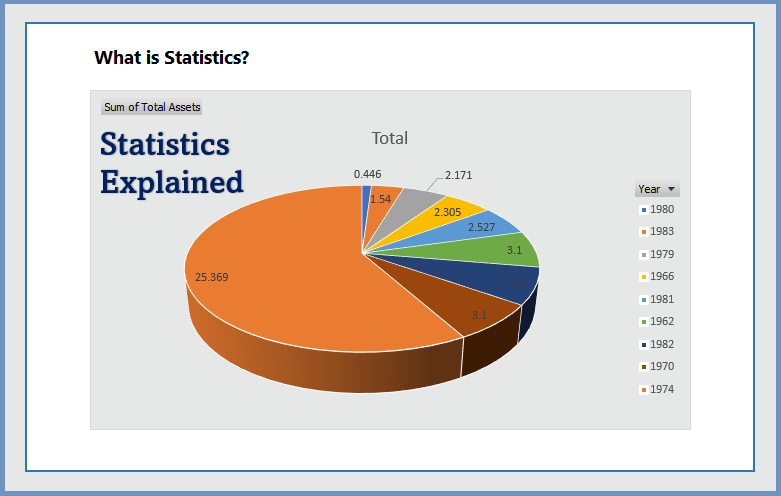What is Statistics?
The term Statistics can be defined in many different ways. First, statistics is a mathematical science that deals with the collection, analysis, and presentation of data, and the findings from this analysis can be used as a basis of inference and induction.
In this section:
- What is statistics?
- Difference between Statistic and Statistics.
- Why Should We Study Statistics?
- Application of Statistics in Data Analysis

1. What is Statistics?
Statistics is a branch of applied mathematics that is involved in collecting, organizing, analyzing, and interpreting numerical facts. Let’s read some definitions from renowned authors:
- Moore, McCabe, and Craig in their book Introduction to The Practice of Statistics, “Statistics is the science of data“.
- Stine and Foster in their book Statistics for Business: Decision Making and Analysis defines Statistics as the science and art of extracting answers from data.
- Anderson, Sweeney, and Williams in their book Modern Business Statistics with Microsoft Excel defines Statistics as the Art and science of collecting, analyzing, presenting, and interpreting data.
- Donnelly Jr. in his book Business Statistics defines, Statistics is the Mathematical Science that deals with the collection, analysis, and presentation of data–data that can then be used as a basis for inference and induction.
All the author describes statistics as a mathematical science, which deals with the collection, analysis, presentation, and interpretation of data.
2. What is the Difference between Statistics and Static?
A statistic such as mean, median, or standard deviation is calculated from a sample. Statistic comes from sample, which is used to come up with some idea of a parameter.
Statistics is a branch of mathematics that deals with the collection, analysis, and presentation of data.

Therefore, we can say that the main difference between Statistic and Statistics is that Statistic is a single measure of some attributes of a sample and Statistics is a study of the collection, organization, analysis, interpretation, and presentation of data.
3. Why Should We Study Statistics?
A common question is “why should we study statistics?” or “Why should we learn statistics?” Let’s see the benefits of learnings statistics?
The Chief Economist of Google, Han Varian, says, “The sexy job in the next ten years will be statisticians. Because now we really do have essentially free and ubiquitous data. So the complimentary factor is the ability to understand that data and extract value from it.”
Then Varian continues,
“The ability to take data – to be able to understand it, to process it, to extract value from it, to visualize it, to communicate it’s going to be a hugely important skill in the next decades, not only at the professional level but even at the educational level for elementary school kids, for high school kids, for college kids. Because now we really do have essentially free and ubiquitous data. So the complimentary scarce factor is the ability to understand that data and extract value from it.”
Here are the top 5 reasons to learn statistics:
- Better business decisions: To make better business decisions, one must learn statistics. Think about making decision without any data. You cannot make decisions without historical data and analysis of those data. You need to know the mean, median, and variation in the data before making decisions.
- Application of numbers in medical science: In the clinical trial, researchers use the statistics. What percentage of patients were cured after taking the medicine. What percentage of patients were suffering from side effects after taking the vaccine? We must know before the vaccine. All these numbers are statistics.
- Job Skills: More and more companies are seeking for candidates who understand data and analytics. To be able to analyze data, one must know statistics as a discipline.
- Higher studies: The higher studies (whether it is research based master degree or PhD degree) require you analyze data and contribute to the research world. To do research, you must know the statistics.
- Society is driven by data: We have billions of data around us. Think how much information is posted on twitter, facebook, youtube, and on other media. To make informed decisions from all these data, you must know how to process them and analyze them. Only data does not make sense and cannot be used to make any decision.
4. Application of statistics in Data Analysis:
In data analysis, data scientists must know and apply statistics. They must have the basic and advanced statistical knowledge such as descriptive statistics, correlation analysis, regression, time series, and multivariate analysis.
More readings:
- Descriptive Statistics in Excel and STATA
- How to Use Correlation in Excel with CORREL Function
- Multiple Correlation in Excel Analysis Tool Pack
- How to Calculate P-Value in Excel
- Multiple Regression in Excel
- Predicting a Variable Based on Other Variables
- Boxplot in Excel, STATA, and Python
- Stem and Leaf Plots
- Scatter Plots in Excel Multiple Series
- Books for For more study

Some truly great articles on this site, regards for contribution. “A liar should have a good memory.” by Quintilian.